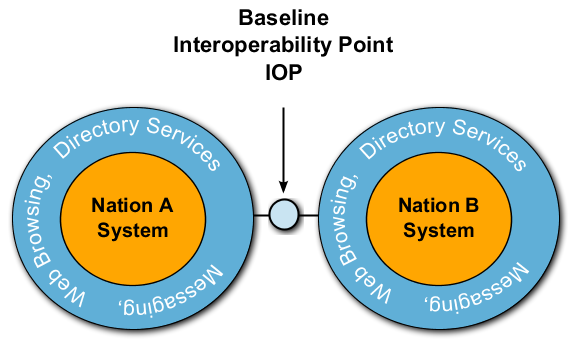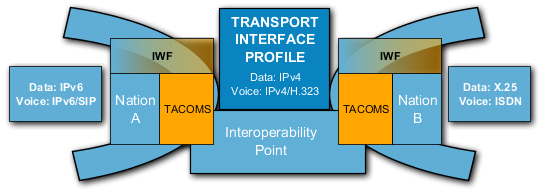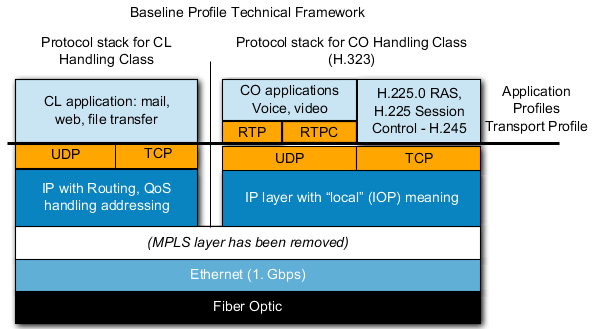B.5. Considerations
B.5.1. Interoperability Point
121. For the purposes of this profile, the Interoperability Point is defined as the interface between two entities (initially NATO Nations) which agree to collaborate through data and information exchange via interconnecting networks.
122. This point defines the information exchange mechanism between two components, and as such requires that an agreement be established as to the protocols and standards that will be adhered to. These parameters must be determined prior to operational readiness. This interface profile will facilitate that dialogue prior to operational information exchange. The notional diagram below is intended to depict this concept.
123. Services that will comprise the initial NRF Baseline Profile are: Directory Services, Web Browsing, and Messaging. As a particular NRF will have multiple interoperability points, there will likely be multiple interface profiles. It is envisioned that each component (Land/Air/Maritime) will utilize a similar solution set for consideration in stand up of an NRF. By presenting the possible, and clearly defining the mandatory and preferred governing technology interface at the interoperability point, increased information sharing for coalition operations will become possible as solutions are more readily identified and implemented.
B.5.2. Interface Profile
124. Decomposition of the previous figure leads to a common understanding of the basic transport to which all solutions shall apply. This diagram shows how two information environments within Nation A and Nation B can differ internally, however, due to use of an agreed upon interface profile at the interoperability point, a common capability can exist between the two nations.
125. This diagram shows how an overlay of an interface profile onto an interoperability point, can achieve integration of national systems into an NRF information environment. The notional diagram was drafted in support of TACOMS POST 2000 however, this generic framework can be decomposed further into a more comprehensive framework, by which solutions will be addressed. This strategy will be employed throughout the various levels of the technical framework listed below, to generate numerous NRF interface profiles.
B.5.3. Baseline Profile Technical Framework
126. To leverage as much of the NATO Enterprise and member Nation solutions in support of the NRF, the development of this profile will assess the full spectrum of technical standards, across the physical, services, and applications layers. A notional representation depicts the layered solutions required for an Interface Profile.
B.5.4. Guidelines for Development
127. Due to the dynamic nature of NRF operations, the intricate C2 structure, and the diversity of nations and communities of interest, interoperability must be anchored in certain key points where information and data exchange between entities exists. The key drivers for defining a baseline set of interoperability NRF interface profiles include:
-
specifications that are service oriented and independent of the technology implemented in national systems,
-
standards based, consistent with common generic architecture,
-
defined Interface points between entities,
-
technologically mature technologies existent within NATO Information Enterprise,
-
modular profiles that are transferable to other NRF components, and
-
open system approach to embrace emerging technologies as they are better defined.
128. The starting point to development of a profile is to clearly define the interoperability point where two entities will interface.
129. The profile set will be divided into application and transport profiles. The application profiles will be divided into a service area. Where required, each service area can have multiple profiles to support a variety of functions required to deliver a service. The predominant transport will be TCP/IP so a single transport profile will be required to deliver the baseline application profiles.
B.5.5. Coalition Interoperability Initiatives
130. Testing of these technical profiles will serve as a means of fostering greater interoperability. The NRF interface profiles must be embedded into the NRF rotation cycle to remain relevant. NATO, led by Allied Command Operations (ACO), constantly pursues test and evaluation initiatives to refine the NRF processes in the time leading up to command for an NRF component. These efforts enhance the effectiveness and interoperability of NATO and National forces working in a coalition environment.
131. NRF planning efforts provide a platform for interoperability and identify new requirements for consideration. Some of these initiatives include: the Coalition Warrior Interoperability Demonstration (CWID); multi-national coalition interoperability projects (COSINE, COSMOS, STP); definition and testing of interoperability requirements (TACOMS Post 2K); and validation of Information Exchange Gateway (IEG) concepts. For Nations requiring modifications to existing profiles, the NISP Request for Change Proposal (RCP) process will be employed. This process will ensure the accuracy and relevancy of NRF interface profiles, based on operational need and experience. Consistent employment of the NRF interface profiles throughout the above activities will also enable the expedient certification and approval to connect into an NRF, should a Nation wish to join an operation under the command of another lead Nation. Collaboration with the operational community will provide a profile representative of the component command and will allow interconnecting Nations to assess net-readiness of a system.


